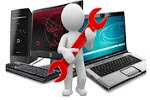10 Effective Ways to Increase Your Computer's Speed
Close unnecessary programs: Close any programs and browser tabs that you're not currently using. Running multiple programs simultaneously can slow down your computer's performance.
Restart your computer: Restarting your computer can help clear out temporary files and processes that may be slowing it down. It's a simple yet effective way to give your computer a fresh start.
Free up disk space: Delete unnecessary files, such as temporary files, unused applications, and old documents or media files. You can use the built-in Disk Cleanup tool on Windows or third-party applications like CCleaner to help you identify and remove unnecessary files.
Disable startup programs: Some programs automatically start when you boot up your computer, which can slow down the startup process. Disable or remove any unnecessary programs from your startup list to improve boot time and overall performance. You can do this through the Task Manager on Windows or the System Preferences on macOS.
Upgrade your hardware: Consider upgrading certain hardware components if your computer is still sluggish. Adding more RAM (random access memory) can help improve multitasking performance, and replacing your hard drive with a solid-state drive (SSD) can significantly boost overall speed and responsiveness.
Scan for malware and viruses: Malware and viruses can significantly slow down your computer. Use a reputable antivirus or antimalware program to scan your system regularly and remove any malicious software that may be affecting performance.
Update software and drivers: Keep your operating system, software applications, and device drivers up to date. Software updates often include performance improvements and bug fixes, while updated drivers can enhance hardware compatibility and performance.
Adjust visual effects: On Windows, you can adjust the visual effects settings to optimize performance. Access the "Performance Options" settings through the Control Panel, and choose the "Adjust for best performance" option or manually disable specific visual effects that you can live without.
Defragment your hard drive (Windows only): If you're using a traditional hard drive (not an SSD), regular defragmentation can help optimize file placement and improve access times. On Windows, you can use the built-in "Defragment and Optimize Drives" tool to defragment your hard drive.
Upgrade your operating system: If you're using an outdated operating system, consider upgrading to the latest version. Newer operating systems often include performance improvements and optimizations.
Remember, the impact of these steps may vary depending on your computer's specifications and the specific issues it's facing. If your computer is still slow after trying these steps, it might be worth consulting with a professional or considering a hardware upgrade.



No comments